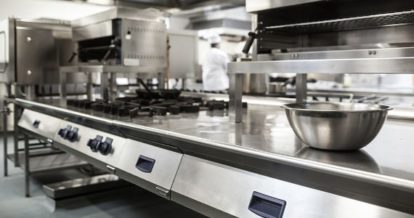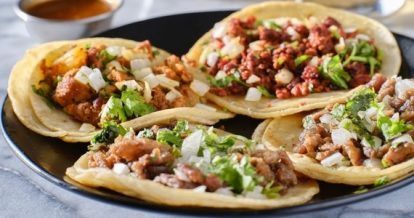Whether you’re new to the restaurant scene or a seasoned veteran in the industry, having the right restaurant equipment list is crucial to your business’s success. With so many different brands, models, and suppliers to choose from, it’s easy to get overwhelmed trying to figure out which purchases are necessary and which are simply money grabs. That’s why we’ve created this comprehensive commercial restaurant equipment list.
In this kitchen equipment list, we’ll cover:
- 24 essential pieces of restaurant equipment
- 6 factors to consider when purchasing restaurant equipment
Let’s get started.
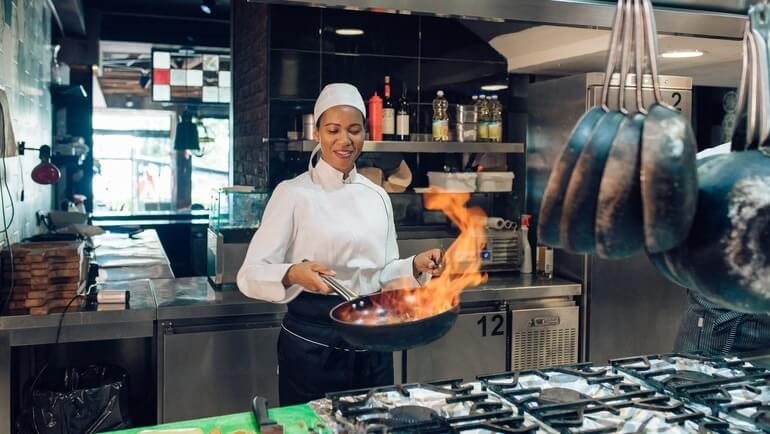
24 Essential Pieces of Restaurant Equipment
Purchasing commercial restaurant equipment is a big investment, so you want to make sure you get it right. Here are the most important materials needed in a restaurant.
1. Ovens
An oven is one of the critical pieces of equipment used in a restaurant kitchen (unless you run a raw food or sushi restaurant, of course). Let’s walk through a few oven options:
- Standard (Radiant): Your basic oven that heats up from the bottom. While this won’t break your bank account, it can cook slowly and inconsistently.
- Convection: This oven is equipped with a fan that circulates air, which helps cook food evenly all the way through while still maintaining its flavor.
- Steam: This fast-cooking oven uses water vapor to cook food. It also cooks evenly, but can’t make food crispy.
- Combination: The best of both a convection and a steam oven. It offers speedy and consistent cooking.
- Conveyor: Similar to a convection oven, but moves food through one side to another where it comes out cooked. Great for pizza.
When looking for an oven, consider which kinds of foods you’ll be cooking most frequently. If you serve a lot of meat dishes, you may want to consider a specialty oven like a rotisserie.
2. Ranges and Ventilation
This is another part of the restaurant equipment list where your decision will depend on your style of cuisine.
- Induction: You can cook at lower temperatures with an induction range than you can with gas. This means you can cook a broader variety of menu items to perfection.
- Gas: This type of range provides chefs with a high level of consistency and control – who could refuse that! It also cooks faster than an electric range.
- Electric: The least pricey option, an electric range is easy to install, cooks evenly, and poses no risk of a dangerous gas leak in your restaurant.
The kind of ventilation you’ll need for the equipment used in a restaurant kitchen depends on how you’ll be cooking. A Type 1 exhaust hood has a built-in fire prevention system to tackle broiling, frying, and grilling, while a Type 2 hood is better suited to baking and steaming.
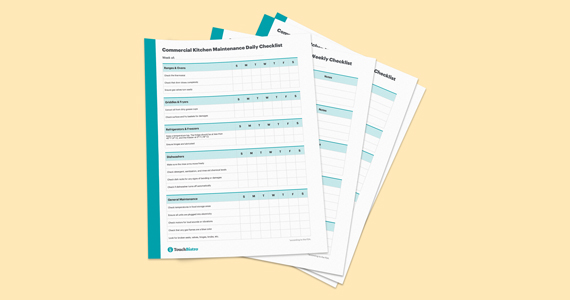
Use this kitchen equipment maintenance checklist to help extend equipment life, reduce utility consumption, and prevent unexpected breakdowns.
3. Food Processors
Slice, chop, grind, puree, grate, and dice – all with one piece of restaurant equipment. Here are the four most common types of food processors:
- Batch Bowl: Your go-to choice for one batch of processed food at a time.
- Continuous Feed: A great option if you process a high volume of food.
- Combination: Gives you the flexibility to make one batch of processed food, or continuously feed ingredients into a chute.
- Buffalo Chopper: Ideal for processing large quantities of veggies or meat.
4. Mixers
Mixers are another must-have piece of commercial restaurant equipment, especially if your menu is full of yummy baked treats. In this case, you’ll probably want to splurge on a standing floor mixer, which can hold 20 to 60 quarts of dough (unlike a countertop mixer, which can only hold up to 20 quarts). However, a countertop mixer may be your best bet if you’re operating in a small space.
5. Slicers
If you’re pumping out charcuterie boards like there’s no tomorrow, you’ll definitely want to invest in an electric slicer to save your staff some time. However, if you only slice the occasional piece of food (think fruit to garnish your desserts), a manual slicer will get the job done for a lower cost.
6. Sharpening Stones
No restaurant equipment list is complete without a set of sharp knives. Purchasing a quality sharpening stone will help maintain your knives’ durability and prevent accidents that can happen as a result of dull blades.
7. Microwave
Every kitchen equipment list should contain a few items to make your life easier, and a microwave fits that bill. This is one of the most common types of equipment used in a restaurant kitchen for finishing touches or single servings. With a microwave, you can reheat pre-made dishes in no time.

Use this kitchen equipment maintenance checklist to help extend equipment life, reduce utility consumption, and prevent unexpected breakdowns.
8. Ice Makers
An automatic ice maker is one of the must-have materials needed in a restaurant, especially if you have a full bar and a wide selection of cocktail offerings. With this piece of commercial restaurant equipment, you’ll be able to satisfy your guests’ cravings whether they prefer their margarita blended or on the rocks. Bottoms up!
9. Gas or Electric Grill
Gas grills are a favorite in restaurant kitchens, since gas heat is more reliable for even cooking. These grills come in many sizes, some even with a flat top conveniently attached. Electric grills, while better for small spaces, aren’t overly popular and don’t provide the rich flavor you can get with a gas or charcoal grill.
10. Griddle
Depending on the kind of restaurant you own, a griddle might work better for your needs than a grill. Serving up pancakes all day? Griddle, please! This piece of equipment used in a restaurant kitchen has a flat, metallic cooking surface that’s perfect for diner mainstays like fried eggs.
11. Deep Fryer
Who doesn’t love deep fried staples like French fries, onion rings, or jalapeño poppers? If you serve pub favorites, a deep fryer needs to be on your restaurant equipment list. You can opt for either a countertop or floor model style depending on your budget and kitchen layout.
12. Commercial Toaster
If your restaurant draws a crowd for breakfast, you can’t afford to slow service down with a tiny toaster. Get bread and bagels on your guests’ plates pronto by purchasing a commercial toaster that can toast anywhere from 60 to 1,600 slices per hour.
13. Coffee Maker
You’ve likely seen enough memes about coffee to know how seriously people take getting their morning cuppa joe – or their second cup, or their third… The bottom line is, if you serve a lot of coffee, you need a commercial coffee maker.

Use this kitchen equipment maintenance checklist to help extend equipment life, reduce utility consumption, and prevent unexpected breakdowns.
14. Prep Counters and Cutting Boards
It’s important to invest in the proper materials needed for restaurant business to make your food prep as sanitary as possible. Wood is very unsanitary – especially when working with meat and poultry – so you’ll want to choose a stainless steel prep table and high-density polyethylene cutting board instead.
15. Fridges and Freezers
Food safety codes require you to store many food items at a minimum temperature, and for that reason, no restaurant equipment list would be complete without a fridge and freezer. Restaurant refrigerators come in all shapes and sizes, from walk-ins to reach-ins. The freezers most commonly found in restaurants are chest freezers, stand-up freezers, and walk-in freezers.
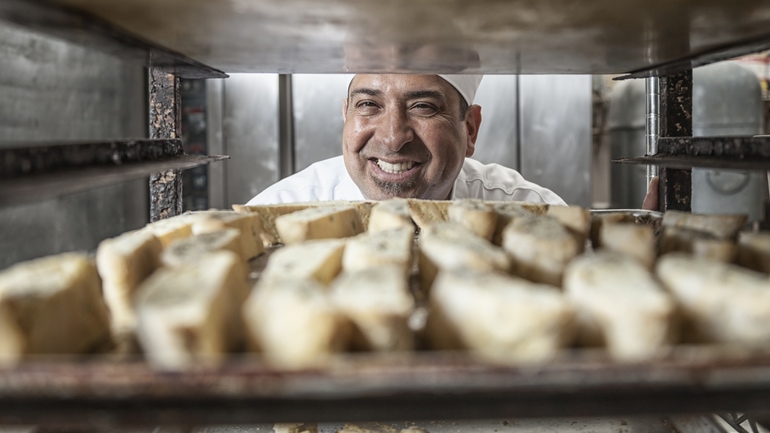
16. Sinks
Even if you have a commercial dishwasher installed in your restaurant kitchen, you’ll still need a three-compartment sink in case it goes on the fritz (which we all know appliances tend to do). One compartment is used for washing, the second for rinsing, and the third for sanitizing. Say hello to sparkling clean dishes!
17. Storage Racks and Shelving
Your restaurant equipment list should take kitchen organization into account. Air drying racks, utility carts, and shelves are all key items to keep your restaurant from looking like a tornado blew through. When storing items on shelves, make sure to keep the things you use most close to ground level, rather than high up, so they’re easily accessible.
18. Washing Equipment
Hand and dishwashing stations are typically required by local health departments. A handwashing station is vital to help prevent the spread of foodborne illnesses and bacteria. Industrial restaurant dishwashers come with all the bells and whistles your business needs, like automatically dispensing dishwashing detergent and keeping water at set temperatures.
19. Steam Tables
Keep pre-cooked foods warm with a steam table. Available in gas or electric options, these tables heat water to produce steam and prevent food from getting cold. These are ideal for self-service restaurants.
20. Kitchen Supplies and Servingware
The materials needed for restaurant business go far beyond equipment like ovens and dishwashers. You’ll also need a variety of kitchen supplies, including pots, pans, tongs, spatulas, serving spoons, plates, bowls, and whatever else your restaurant concept might require.

Use this kitchen equipment maintenance checklist to help extend equipment life, reduce utility consumption, and prevent unexpected breakdowns.
21. Storage Containers
When stocking your restaurant kitchen, be sure to pick up an assortment of containers with colored lids in different sizes, so you can keep your dry ingredients and sauces organized and easily identifiable.
22. Safety Equipment
Required by state and federal law, your business must be up to safety standards. A first-aid kit is one of the must-have materials needed in a restaurant. It has to be accessible in the workplace at all times, along with a fire extinguisher.
23. Kitchen Display System (KDS)
Bid farewell to handwritten order tickets by using a digital kitchen display system alongside your ticket kitchen printer and bump bar. Link this tool to your front of house point of sale system to make it easier for kitchen staff to manage incoming orders.
24. Point of Sale (POS)
One of the most essential kitchen technologies is a restaurant point of sale system like TouchBistro POS, which enables you to streamline your operations and boost your bottom line by managing your menu, inventory, and staff all in one place.

What to Consider When Purchasing Restaurant Kitchen Equipment
We’ve now covered all the materials needed for restaurant business success. But before you take your kitchen equipment list and go shopping, let’s dig into a few key factors to consider.
1. Quality
Whether you choose to buy used or new restaurant equipment will depend primarily on your budget. While new equipment will likely last you longer, used could be gentler on your wallet in the short term, as long as you’re sure you won’t need to replace it right away. If you can swing it, try to get high-quality equipment.
2. Size and Space
The restaurant equipment you purchase will also depend largely on your commercial kitchen layout. If you have spacious digs, you can opt for some of the bigger items we covered, like a standing floor mixer.
3. Ease of Use and Cleaning
Don’t be fooled by smoke and mirrors when shopping for restaurant equipment. The items you buy need to be straightforward for your kitchen staff to use, and simple to clean. Otherwise, you might find yourself heading back to the store.

Use this kitchen equipment maintenance checklist to help extend equipment life, reduce utility consumption, and prevent unexpected breakdowns.
4. Pricing
Set a budget for your restaurant equipment to help you decide which items to spend more money on, and which ones to compromise on. Perhaps you can wait until next year to get the fancy food processor that’s caught your eye.
5. Installation and Maintenance
You should always vet several suppliers and ask about whether they’ll help with the installation of your restaurant equipment. Additionally, find out whether they offer ongoing maintenance, which you’ll likely need at some point.
6. Leasing Options
Restaurant equipment financing can help you get the items you need, even if you’re on a budget. With a traditional lease, you pay to use the equipment, but you don’t own it. In contrast, equipment financing allows you to repay a lender the cost of a piece of equipment over time until you do own it. Either way, you won’t have to shell out a large sum of cash upfront.
Stocking up on the materials needed for restaurant business success doesn’t have to be a daunting task. With the help of this kitchen equipment list, you can get the best for your restaurant without spending money on passing fads. Happy shopping!
Get the Complete Guide to Restaurant Reservations
Sign up for our free weekly TouchBistro Newsletter

